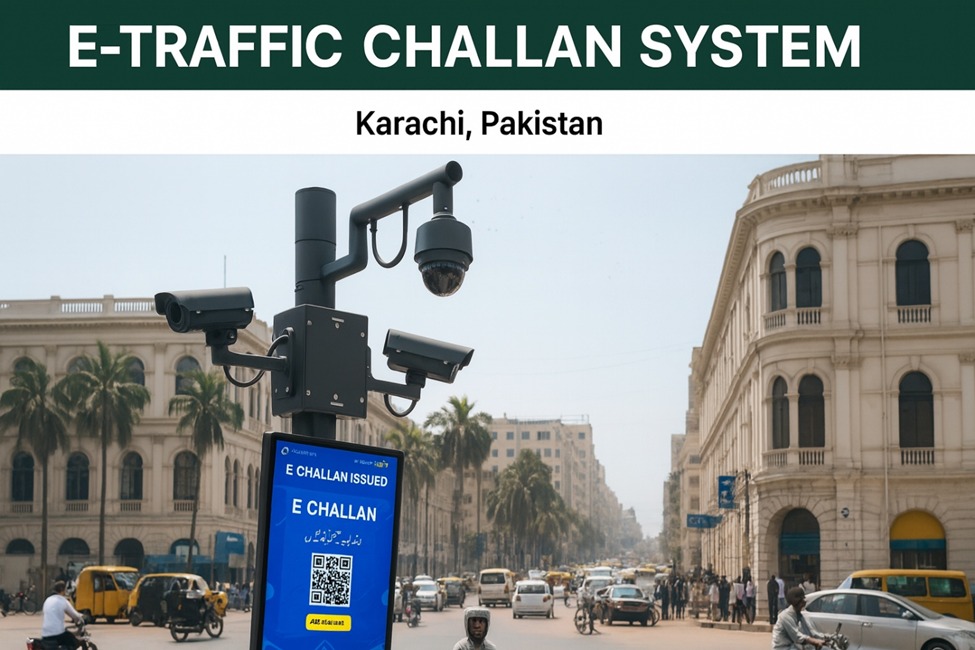The E-Traffic Challan System in Karachi: A Balanced, Evidence-Based Overview
-
Web Desk
-
- Published November 28, 2025

Introduction
Traffic management has long been a challenge in Karachi, a city where rapid population growth, limited road infrastructure, and inconsistent enforcement have contributed to chronic congestion and rising accident rates. In recent years, authorities have turned to technology to modernize enforcement, leading to the introduction of the e-traffic challan system. This digital approach aims to streamline how violations are recorded, communicated, and paid. As the system expands across Karachi and other parts of Pakistan, it has sparked debate among citizens, employers, and policymakers. This article provides an objective look at how the system works, how people are experiencing it, and what its wider social and economic impact may be.
Overview of the System
The e-traffic challan system replaces traditional manual ticketing with an electronic process. Instead of relying solely on roadside police officers issuing paper slips, the new model uses digital tools – including cameras, online databases, and automated record-keeping – to issue and store violation notices. Drivers can check their challans through official websites, SMS services, or mobile applications using their vehicle registration number or ID.
At its core, the system aims to achieve three goals:
- Improve efficiency: Digitalization reduces paperwork, minimizes human error, and speeds up the process of issuing and recording fines.
- Reduce discretionary interaction: With fewer manual stops, there are fewer opportunities for informal negotiation or misconduct between officers and drivers.
- Increase compliance: Automated systems can capture violations that officers might miss, potentially encouraging safer and more consistent driving habits.
Payment channels have broadened as well. Motorists can settle fines through banks, mobile wallets, and designated online gateways, making the process more accessible than traditional government payment counters. Authorities argue that centralizing data also helps identify habitual offenders and improves overall traffic planning.
While the concept is straightforward, the sudden increase in recorded violations during initial rollout phases has drawn attention. As digital systems tend to capture violations more consistently, many drivers have discovered multiple outstanding challans they were previously unaware of.
Impact on Citizens
For everyday road users, the e-challan system has had mixed effects. On one hand, it introduces a transparent and predictable method for dealing with fines. On the other, it has created concerns over affordability, fairness, and access.
Financial pressure is a key issue.
Many citizens have reported receiving several fines at once, sometimes accumulated over weeks or months. For low-income households, even a handful of moderate fines can become a significant burden. Because traffic behavior in Karachi has long been shaped by inconsistent enforcement, many drivers argue they were not aware that certain actions – such as minor lane violations or brief parking infractions – would now be automatically penalized.
Digital literacy and access also matter.
Although the system is designed to be convenient, not everyone has easy access to the internet, online payment tools, or the knowledge needed to navigate government portals. Older drivers and those from lower-income areas may struggle more than others. Without widespread public awareness campaigns, many people only discover their challans when attempting to renew documents or when stopped by traffic police.
Concerns about accuracy and dispute processes have also surfaced.
Digital systems rely heavily on camera footage and automated readings, which can sometimes misidentify plate numbers or assign violations to the wrong person. Citizens frequently request clearer mechanisms for contesting fines, including faster review processes, easier submission of evidence, and transparency about how appeals are decided.
Despite these challenges, the system has also provided benefits for citizens who previously found manual payment procedures slow or intimidating. For many, being able to check and pay a challan from home is a welcome improvement.
Institutional and Employer Perspectives
From the perspective of law enforcement and government agencies, the e-challan system represents progress toward modern traffic governance. Digital records help police track trends, identify hotspots, and reduce reliance on field officers for routine enforcement. The system also creates clear audit trails, which can support accountability efforts.
Institutions generally highlight three advantages:
- Administrative efficiency:
Centralized data storage simplifies the monitoring of violations and improves coordination between departments. - Safety improvement:
Automated enforcement is expected to reduce risky behaviors such as speeding and ignoring signals. - Reduced conflict:
With fewer direct interactions between officers and motorists, the potential for disputes or misconduct decreases.
Employers, especially companies managing large fleets – such as logistics firms, ride-hailing platforms, and delivery services – face a more complicated reality. While the system helps them keep track of violations by drivers, it also introduces financial and administrative burdens. Companies must decide whether fines should be deducted from salaries, shared between employer and employee, or absorbed as operating costs.
Some organizations have reported using e-challan data to train drivers, strengthen safety protocols, or adjust routes to reduce violations. However, without clear policy guidelines, employers often face ambiguity around liability when a challan is linked to a vehicle rather than a specific driver.
Broader Economic and Social Implications
The ripple effects of the e-traffic challan system extend beyond individual drivers and institutions.
Economic Effects
In the short term, the system can generate higher revenue due to better detection and collection of fines. Governments may use this income to improve road infrastructure or traffic management systems. However, critics warn that focusing too heavily on revenue can undermine trust if citizens perceive fines as more of a financial tool than a safety measure.
Digital enforcement may also influence insurance markets, vehicle financing, and the resale value of cars if violation histories become integrated into official records. Over time, consistent enforcement could reduce accidents, which would lessen economic losses due to medical costs, property damage, and lost productivity.
Social and Behavioral Effects
When consistently applied, e-challans can reshape driving behavior. Increased accountability may encourage safer habits, reduce congestion caused by chaotic driving, and lower accident rates. However, for long-term effectiveness, enforcement must be paired with public education, infrastructure improvements, and better road design.
The system also raises important questions about digital inclusion. If certain groups lack the resources or digital skills to navigate electronic processes, they may be disproportionately penalized. Equity concerns are especially relevant in cities like Karachi, where socioeconomic disparities are wide.
Governance and Transparency
As digital enforcement becomes more embedded in public administration, data privacy and oversight become critical. Citizens want clarity on who can access violation data, how long records are stored, and what protection exists against misuse. Transparent policies, regular audits, and public reporting can help maintain trust in the system.
Conclusion
The e-traffic challan system in Karachi marks an important step in Pakistan’s broader shift toward digital governance. It offers clear benefits: more transparent enforcement, easier payment options, and the potential for safer roads. At the same time, citizens’ concerns about affordability, accuracy, and digital access highlight the need for continuous improvement.
A balanced path forward would include more public awareness campaigns, clear dispute-resolution procedures, policies to support digitally excluded groups, and periodic reviews of fine amounts to ensure fairness. Further research on long-term accident trends, payment patterns, and public feedback will be essential to determine how well the system delivers on its promise of safer, more efficient transportation for everyone.





Leave a Reply